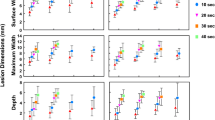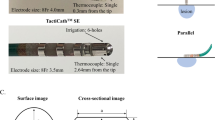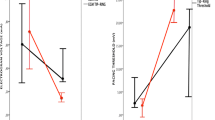Abstract
Background: Several catheter technologies for creating large radiofrequency (RF) lesions are used in clinical practice, but direct comparisons of the pathological lesions created by these technologies are unavailable. The purpose of this study was to compare the safety and efficacy of lesions created by three different large lesion RF ablation technologies.
Methods and Results: RF lesions were created in all four chambers of 15 mongrel dogs using 10 mm-tip multiple temperature sensor catheters, 10 mm tip single temperature sensor catheters, and 4 mm cooled-tip catheters. Pathological lesions were bisected, and measured after viability staining. A total of 242 (79 large-tip single sensor, 82 large-tip multiple sensor, and 81 cooled-tip) lesions were created. All atrial lesions were transmural but tended to have larger surface areas with the single thermistor large-tip catheter (73.4 ± 24.8 mm2) compared to either the multithermistor large-tip (60.9 ± 28.3 mm2) or the cooled-tip (61.9 ± 28.5 mm2) catheters (p = 0.07), especially those in the IVC-TA isthmus. Depths and volumes of ventricular lesions created by the multiple-thermistor catheter (5.0 ± 1.5 mm; 260 ± 168 mm3) were smaller than either the single thermistor (5.7 ± 1.5 mm; 428 ± 290 mm3) or cooled-tip (6.1 ± 1.8 mm; 403 ± 217 mm3) catheters (p < 0.05). The difference in the depth and volume of lesions made by large-tip single thermistor and cooled-tip catheters was not significant. Char formation occurred during 11% of ablation with the single thermistor catheter, 6% with multithermistor and 8% of cooled-tip catheter (p = NS). There were no complications of ablation.
Conclusions: All three catheters reliably created full thickness atrial lesions. For ventricular lesions, depths and volumes were similar for 10 mm-tip single thermistor and cooled-tip catheters. The multithermistor catheter lesions were smaller due to more precise temperature regulated power control. Safety was similar in all 3 groups.
Similar content being viewed by others
References
Haines DE. The biophysics and pathophysiology of lesion formation during radiofrequency catheter ablation. In Zipes DP, Jalife J (eds), Cardiac Electrophysiology: From Cell to Bedside. Philadelphia, WB Saunders, 2000:983–993.
Haines DE, Verow AF. Observations on electrode-tissue interface temperature and effect on electrical impedance during radiofrequency ablation of ventricular myocardium. Circulation 1990;82:1034–1038.
Mittleman RS, Huang SK, DeGuzman WT, Cuenoud H, Wagshal AB, Pires LA. Use of the saline infusion electrode catheter for improved energy delivery and increased lesion size in radiofrequency catheter ablation. Pacing Clin Electrophysiol 1995;18:1022–1027.
Nakagawa H, Yamanashi WS, Pitha JV, Arruda M, Wang X, Ohtomo K, Beckman KJ, McClelland JH, Lazzara R, Jackman WM. Comparison of in vivo tissue temperature profile and lesion geometry for radiofrequency ablation with a saline-irrigated electrode versus temperature control in a canine thigh muscle preparation. Circulation 1995;91:2264–2273.
Otomo K, Yamanashi WS, Tondo C, Antz M, Bussey J, Pitha JV, Arruda M, Nakagawa H, Wittkampf FH, Lazzara R, Jackman WM. Why a large tip electrode makes a deeper radiofrequency lesion: Effects of increase in electrode cooling and electrode-tissue interface area. J Cardiovasc Electrophysiol 1998;9:47–54.
Langberg JJ, Gallagher M, Srickberger SA, Amirana O. Electrophysiology: Temperature-guided radiofrequency catheter ablation with very large distal electrodes. Circulation 1993;88:245–249.
McRury ID, Panescu D, Mitchell MA, Haines DE. Nonuniform heating during radiofrequency catheter ablation with long electrodes: Monitoring the edge effect. Circulation 1997;96:4057–4064.
Haines DE. Watson DD. Verow AF. Electrode radius predicts lesion radius during radiofrequency energy heating. Validation of a proposed thermodynamic model. Circ Res 1990;67:124–129.
Dorwarth U, Fiek M, Remp T, Reithmann C, Dugas M, Steinbeck G, Hoffmann E. Radiofrequency catheter ablation: different cooled and noncooled electrode systems induce specific lesion geometries and adverse effect profiles. Pacing Clin Electrophysiol 2003;26:1438–1445.
d'Avila A, Houghtaling C, Gutierrez P, Vragovic O, Ruskin JN, Josephson ME, Reddy VY. Catheter ablation of ventricular epicardial tissue: A comparison of standard and cooled-tip radiofrequency energy. Circulation 2004;109:2363–2369.
Tsai CF, Tai CT, Yu WC, Chen YJ, Hsieh MH, Chiang CE, Ding YA, Chang MS, Chen SA. Is 8-mm more effective than 4-mm tip electrode catheter for ablation of typical atrial flutter? Circulation 1999;100:768–771.
Rodriguez L, Nabar A, Timmerans C, Wellens HJ. Comparison of results of an 8-mm split-tip versus a 4-mm tip ablation catheter to perform radiofrequency ablation of type I atrial flutter. Am J Cardiol 2000;85:109–112.
Kasai A, Anselme F, Teo WS, Cribier A, Saodi N. Comparison of effectiveness of an 8-mm versus a 4-mm tip catheter for radiofrequency ablation of typical atrial flutter. Am J Cardiol 2000;86:1029–1032.
Jais P, Haissaguerre M, Shah DC, Takahashi A, Hocini M, Lavergne T, Lafitte S, Le Mouroux A, Fischer B, Clementy J. Successful irrigated-tip catheter ablation of atrial flutter resistant to conventional radiofrequency ablation. Circulation 1998;98:835–838.
Schreieck J, Zrenner B, Kumpmann J, Ndrepepa G, Schneider MA, Deisenhofer I, Schmitt C. Prospective randomized comparison of closed cooled-tip versus 8-mm-tip catheters for radiofrequency ablation of typical atrial flutter. J Cardiovasc Electrophysiol 2002;13:980–985.
Marrouche NF, Schweikert R, Saliba W, Pavia SV, Martin DO, Dresing T, Cole C, Balaban K, Saad E, Perez-Lugones A, Bash D, Tchou P, Natale A. Use of different catheter ablation technologies for treatment of typical atrial flutter: Acute results and long-term follow-up. Pacing Clin Electrophysiol 2003;26:743–746.
Scavee C, Georger F, Jamart J, Mancini I, Collet B, Blommaert D, De Roy L. Is a cooled tip catheter the solution for the ablation of the cavotricuspid isthmus? Pacing Clin Electrophysiol 2003;26:328–331.
Scavee C, Jaïs P, Hsu LF, Sanders P, Hocini M, Weerasooriya R, Macle L, Raybaud F, Clementy J, Haïssaguerre M. Prospective randomised comparison of irrigated-tip and large-tip catheter ablation of cavotricuspid isthmus-dependent atrial flutter, Eur Heart J 2004;25:963–969.
Pappone C, Oral H, Santinelli V, Vicedomini G, Lang CC, Manguso F, Torrracca L, Benussi S, Alfieri O, Hong R, Lau W, Hirata K, Shikuma N, Hall B, Morady F. Atrio-esophageal fistula as a complication of percutaneous transcatheter ablation of atrial fibrillation. Circulation 2004;109(22):2724–2726.
Chan RC, Johnson SB, Seward JB, Packer DL. The effect of ablation electrode length and catheter tip to endocardial orientation on radiofrequency lesion size in the canine right atrium. PACE 2002;25:4–13.
Nakagawa H, Wittkampf FH, Yamanashi WS, Pitha JV, Imai S, Campbell B, Arruda M, Lazzara R, Jackman WM. Inverse relationship between electrode size and lesion size during radiofrequency ablation with active electrode cooling. Circulation 1998;98:458–465.
Author information
Authors and Affiliations
Corresponding author
Rights and permissions
About this article
Cite this article
McGreevy, K.S., Hummel, J.P., Jiangang, Z. et al. Comparison of a Saline Irrigated Cooled-Tip Catheter to Large Electrode Catheters with Single and Multiple Temperature Sensors for Creation of Large Radiofrequency Lesions. J Interv Card Electrophysiol 14, 139–145 (2005). https://doi.org/10.1007/s10840-006-5635-1
Received:
Accepted:
Published:
Issue Date:
DOI: https://doi.org/10.1007/s10840-006-5635-1




